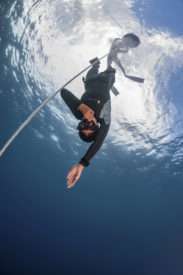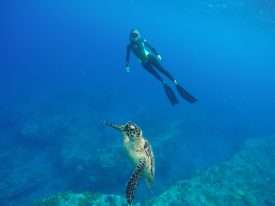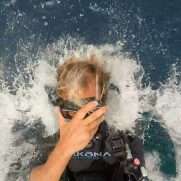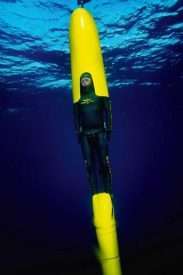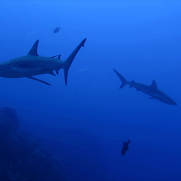
| Bonaire Freediving School offers single and multiple day freediving trips that include training while enjoying many of the different Bonaire diving sites.
From Shore guided Freediving tour. From shallow patch reefs to deep wrecks, Bonaire offers sites suitable for any freediver’s level of experience. Freediving has some advantages to spot pelagic creatures that are not normally seen by all divers. Unusual and exciting sightings are always possible in Bonaire’s waters including frequent animal encounters encounters.
|
Bonaire offers year-round freediving with seasonal differences in water temperature and surface conditions. The water temperature varies between 26C and 28C (77F-84F). Visibility ranges from a minimum of 20m (60ft) to virtually unlimited. Swells and heavy rainfall may influence visibility, but typically it clears again very quickly. Due to the rocky of the coastal zone, some shore freediving are not easy . Therefore all freediving activities must be under the supervision of one of our instructors . Their expertise contributes to a safe, convenient and informative diving experience.
From Boat freediving trips.
The boat trips start at 9 am from our location in Fort Bay and as standard are run in groups no bigger than 6. If you have more people then please contact us to discuss your needs.
The exceptional character of the underwater world of Saba comes from its volcanic origins. The seabed is highly varied. You will find bizarre looking pinnacles in one place and the next you will see lava tunnels with warm water currents which attract specific kind of fish.
The pinnacles are a rarity. The rock formations Third Encounter, twilight Zone, Outer Limits and Shark Shoals are particularly remarkable. From unfathomable depths, they stick straight up until daylight reaches their summits. If you steer a middle course between the lava rocks and the ladder labyrinth, you will feel you are in a maze. Freedivers miss nothing. Visibility is sometimes over 90 meters.
Saba Freediving School Is all about finding relaxation and enjoyment in the water, which is essential whether you are a recreational freediver, or intend to train seriously for depth increase. Being calm in the water – and knowing how to create that state in your mind and body every time – is the most important part of making a successful and beautiful dive.

From Shore guided Freediving tour.
We offer a range of freediving trips to various locations around Saba. These trips are tailor made for freedivers with specific emphasis on training your apnea skills and exploring some of the best sights around Saba coast
We will aim to freedive in the best locations (around the island) given the weather on the day to give you the best experience and sea conditions possible. Some locations do require long walk and hiking to get to the sea, but it will be worth it as these are often the best spots!
The trips start at 10 am from our location in Windwarside and as standard are run in groups no bigger than 6. If you have more people then please contact us to discuss your needs.
You must be able to swim unaided 200m and be over 15yrs old to join the tour. Please arrive on the day with your own wetsuit (a full suit or rash Gard) ,or hire one from us. The trip lasts 3 hrs in total. We would expect to be in the sea for 1 1/2 – 2 hrs in this time. Longer or multiple location trips are available on demand.

Price $78
- About 2 Hours in the water
- Freediving in Wells Bay and other great dive sites
- Swimming and Drift freedive over spectacular rock formations
- Transport
- Aida professional Guidance
- Equipment hire (not inluded)
Departing from the shop at 08:30
returning to the shop at 14:30
